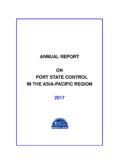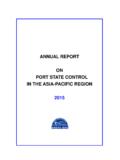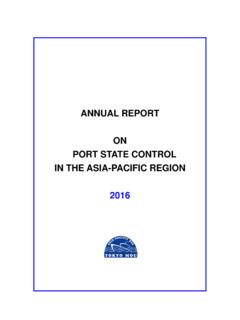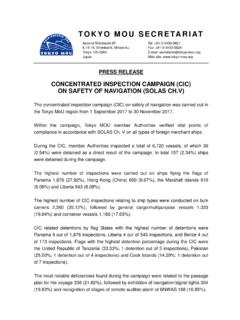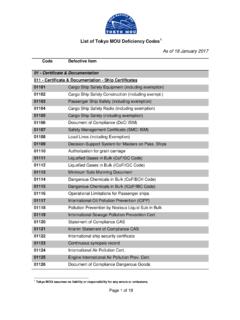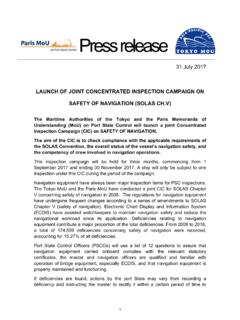Transcription of Memorandum of Understanding on Port State Control in …
1 Memorandum of Understanding on Port State Control in the Asia-Pacific Region -1- Memorandum OF Understanding ON PORT State Control IN THE ASIA-PACIFIC REGION * The Maritime Authorities of Australia 1) New Zealand 6) Canada 2) Papua New Guinea 6) Chile 3) Peru 9) China 1) Philippines 10) Fiji 4) Russian Federation 11) Hong Kong, China 1) Singapore 12) Indonesia 5) Solomon Islands 13) Japan 6) Thailand 14) Republic of Korea 7) Vanuatu 15) Malaysia 6) Viet Nam 16) Marshall Islands 8) hereinafter referred to as "the Authorities" Recognizing the importance of the safety of life at sea and in ports and the growing urgency of protecting the marine environment and its resources; Recalling the importance of the requirements set out in the relevant maritime conventions for ensuring maritime safety and marine environment protection; * This text contains the seventeenth amendments adopted on 21 September 2017 with the effect on 1 February 2018.
2 1) Accepted the Memorandum on 11 April 1994. 2) Accepted the Memorandum on 15 April 1994. 3) Became a member Authority on 10 June 2002 in accordance with paragraph of the Memorandum . 4) Accepted the Memorandum on 1 June 1996. 5) Accepted the Memorandum on 1 April 1996. 6) Accepted the Memorandum on 1 April 1994. 7) Accepted the Memorandum on 7 April 1994. 8) Became member Authority on 28 October 2013 in accordance with paragraph of the Memorandum . 9) Became member Authority on 5 October 2015 in accordance with paragraph of the Memorandum . 10) Accepted the Memorandum on 9 September 1997. 11) Accepted the Memorandum on 1 April 1995. 12) Accepted the Memorandum on 9 April 1994. 13) Not yet accepted the Memorandum . 14) Accepted the Memorandum on 1 May 1996.
3 15) Accepted the Memorandum on 26 April 1994. 16) Accepted the Memorandum on 1 January 1999. Memorandum of Understanding on Port State Control in the Asia-Pacific Region -2- Recalling also the importance of the requirements for improving the living and working conditions at sea; Noting the resolutions adopted by the International Maritime Organization (IMO), and especially Resolution (17) adopted at its 17th Assembly, concerning regional co-operation in the Control of ships and discharges; Noting also that the Memorandum is not a legally binding document and is not intended to impose any legal obligation on any of the Authorities; Mindful that the principal responsibility for the effective application of standards laid down in international instruments rests upon the administrations whose flag a ship is entitled to fly.
4 Recognizing nevertheless that effective action by port states is required to prevent the operation of substandard ships; Recognizing also the need to avoid distorting competition between ports ; Convinced of the necessity, for these purposes, of an improved and harmonized system of port State Control and of strengthening cooperation and the exchange of information; have reached the following Understanding : Section 1 General Each Authority that has accepted the Memorandum will give effect to the provisions of the present Memorandum . For the purposes of the Memorandum , references to the "region", to "regional", to "regional ports " or to "regional port State Control " mean the Asia-Pacific region, and references to "port State " means the states , and the territories recognized as Associate Members of IMO in which the ports are located.
5 Each Authority will establish and maintain an effective system of port State Control with a view to ensuring that, without discrimination, foreign merchant ships calling at a port of its Authority, or anchored off such a port comply with the standards laid down in the relevant instruments as defined in section 2. Each Authority, under the coordination of the Committee established pursuant to paragraph , will determine an appropriate annual percentage of individual foreign merchant ships, hereinafter referred to as "ships", to be inspected. The Committee will monitor the overall inspection activity and its effectiveness throughout the region. As the target, subject to subsequent review, the Committee will endeavour to attain a regional annual inspection rate of 80% of the total number of ships operating in the region.
6 The percentage is based on the number of ships which entered regional ports during a recent base period to Memorandum of Understanding on Port State Control in the Asia-Pacific Region -3- be decided by the Committee. Each Authority will consult, cooperate and exchange information with the other Authorities in order to further the aims of the Memorandum . Section 2 Relevant Instruments For the purposes of the Memorandum , the following are the relevant instruments on which regional port State Control is based: .1 the International Convention on Load Lines 1966; .2 the Protocol of 1988 relating to the International Convention on Load Lines, 1966; .3 the International Convention for the Safety of Life at Sea, 1974 as amended; .4 the Protocol of 1978 relating to the International Convention for the Safety of Life at Sea, 1974.
7 5 the Protocol of 1988 relating to the International Convention for the Safety of Life at Sea, 1974; .6 the International Convention for the Prevention of Pollution from Ships 1973, as modified by the Protocol of 1978 relating thereto; .7 the International Convention on Standards for Training, Certification and Watchkeeping for Seafarers, 1978, as amended; .8 the Convention on the International Regulations for Preventing Collisions at Sea, 1972; .9 the International Convention on Tonnage Measurement of Ships, 1969; .10 the Merchant Shipping (Minimum Standards) Convention, 1976 (ILO Convention No. 147); .11 the Maritime Labour Convention, 2006 (MLC, 2006); .12 the International Convention on the Control of Harmful Anti-fouling Systems on Ships, 2001.
8 13 the Protocol of 1992 to amend the International Convention on Civil Liability for Oil Pollution Damage, 1969 (CLC PROT 1992); and .14 the International Convention for the Control and Management of Ships Memorandum of Understanding on Port State Control in the Asia-Pacific Region -4- Ballast Water and Sediments, 2004 (BWM 2004). With respect to the Merchant Shipping (Minimum Standards) Convention, 1976 (ILO Convention No. 147) and MLC, 2006, each Authority will be guided by the instructions in Sections 2-2*, ** and ** of the Asia-Pacific Port State Control Manual (hereinafter referred to as the Manual ). The implementation of ILO Convention No. 147 will not require any alterations to structure or facilities involving accommodation for ships whose keels were laid down before April 1, 1994.
9 The implementation of MLC, 2006, will not require any alternations to structure or facilities involving accommodation for ships whose keels were laid down before 20 August 2013. In the application of the other relevant instruments, each Authority will be guided by the standards specified in Section 2-1** of the Manual. Each Authority will apply those relevant instruments which are in force and are binding upon it. In the case of amendments to a relevant instrument each Authority will apply those amendments which are in force and which are binding upon it. An instrument so amended will then be deemed to be the 'relevant instrument' for that Authority. In applying a relevant instrument for the purpose of port State Control , the Authorities will ensure that no more favourable treatment is given to ships entitled to fly the flag of a non-party to that instrument.
10 When inspecting ships for provisions of the relevant instruments to which it is a Party, the Authority as the port State will not impose standards on foreign ships that are in excess of standards applicable to ships flying the flag of that port State . Section 3 Inspection Procedures, Rectification and Detention In implementing this Memorandum , the Authorities will carry out inspections, which will consist of at least a visit on board a ship in order to check the certificates and documents, and furthermore satisfy themselves that the crew and the overall condition of the ship, its equipment, machinery spaces and accommodation, and hygienic conditions on board, meets the provisions of the relevant instruments. In the absence of valid certificates, or if there are clear grounds for believing that the crew or the condition of the ship or its equipment does not substantially meet the requirements of a relevant instrument, or the master or crew are not familiar with essential shipboard procedure relating to the safety of ships or the prevention of pollution, a more detailed inspection will be carried out.
